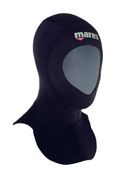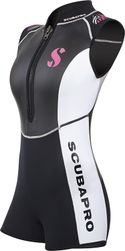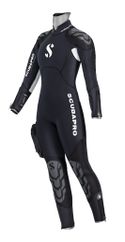Protection against cold
Protection against cold refers in diving mainly to diving suit, hood, gloves and booties, which serve to protect the diver in the water from excessive cooling. The type and extent of the protective equipment must be selected according to the expected minimum water temperature.
Furthermore, the protective equipment also provides some protection against skin injuries.
Contents
Basic knowledge for Open Water Diver* (OWD*)
Since water transports heat much better than air, you have to wear a suitable protection against the cold while diving to avoid hypothermia. Type, material thickness and components of the protective equipment must be selected according to the lowest expected water temperature. At temperatures below 20°C, you have to wear complete protection against cooling, i. e. diving suit, hood, booties and gloves.
Should you get cold during the dive, then indicate this immediately with the appropriate underwater sign to your dive partner and end the dive, as even a slight hypothermia may impair the ability to act.
Neoprene
Normal protective equipment for wet diving consists of laminated, foamed neoprene. The insulating effect of neoprene is mainly caused by its embedded air bubbles. As protection against damage neoprene is externally covered with a nylon fabric (lamination). It is also laminated inside to make dressing easier.
The insulating air bubbles are subject to Boyle's law. Remembering physics, air compresses and so, the enclosed air bubbles become smaller with increasing depth. This has a negative effect on both, buoyancy and thermal insulation: Both are reduced by about 80% at a depth of 40 m compared to the water surface.
The insulation and buoyancy depend on the thickness of the material. Depending on the purpose of use, this is typically between 1 mm and 10 mm. Neoprene also undergoes an aging process. It will become harder and thinner over time, depending on the number of dives, the number of flights and the exposure to UV radiation from the sun. Neoprene is available in different degrees of hardness. Hard neoprene is long-term stable, while soft neoprene ages faster.
Neoprene itself is waterproof. Water only penetrates through unsealed seams, zips and at the openings for head, hands or feet.
Contents
Complete protection against cold consists of the following components.
Diving suit
The diving suit is the main component of the protection against cold. At moderate water temperatures, wet or semi-dry suits are used. They typically consist of a full-body suit over which optionally a vest or shorty for additional thermal insulation can be worn. There are also shorties that have shortened sleeves and legs. They are only suitable in tropical waters and do not protect against skin injuries to the arms and legs. The most common neoprene thicknesses are 3 mm for tropical waters, 5 mm for warm waters above 24°C and 7 mm for colder waters below 24°C.
When several dives a day are performed during holidays on some consecutive days, the body cools increasingly even in warm water. At the beginning of the holiday you still feel the water temperature is pleasant and you are also distracted by many new impressions. After a few days you start to get cold earlier and earlier. That's why you should use rather a thicker than a to thin diving suit even in warm waters. If the air temperature is very high, you should wait with wearing the dive suit until just before the dive and stay in the shade as much as possible, to prevent overheating and dehydration.
Diving suits get tighter over time, even without extendig your body weight. If the suit gets to tight the problem is that breathing might get restricted by physical exertion, which may cause breathlessness. This is often mistaken as regulator problem.
Hood
Since the brain is very well supplied with blood, the human body loses a large amount of its body heat over the head. This makes a hood an essential part of the cold protection. It also makes it easier to put on your mask especially with long hair.
In older suit models, the hood is usually attached to the diving suit. For reasons of flexibility, modern suits usually use separate hoods. These are available in different material thicknesses and versions.
The hood should cover parts of the face. Care must be taken by putting on your mask. Make sure the hood lays around the mask and not the mask on the edges of your hood.
Usually there is a small hole at the top, through which air, which gets trapped under the hood during the dive, can escape. However, this air can also be very pleasant, since it also contributes to the thermal insulation. Downside is that it also adds to positive buoyancy especially at the end of the dive during your last deco or safety stop.
Booties
Booties usually consist of 5 mm to 7 mm thick neoprene and have rubber-reinforced soles to allow comfortable walking on shore. Only open-heel fins can be used with booties.
For additional protection against the cold, you can wear thin neoprene socks (so-called hot-socks) under the booties.
Gloves
Skin which has been softened by water is particularly prone to injury. Therefore wearing gloves is not only a protection against cold, they protect also against injury. Depending on the water temperature, there are gloves in different variations and neoprene thicknesses.
Even if the feel of your fingertips is impaired while wearing thick gloves, soon as the water temperature goes below 20°C gloves become essential. You do not have to perform any fine motor skills with your fingers underwater. Within a few dives you will get the hang of operating your inflator, opening and closing your BCD pockets while wearing gloves. There is no but, cause you will have more problems with impaired feel in your fingers when they are uncomfortably cold.
Care and repair
All neoprene parts should be rinsed regularly with fresh water, especially if you have been diving in salt water or after pool sessions. Neoprene is washable in the washing machine at about 40°C with mild detergent, but without spin cycle. If possible, you should dry neoprene gear turned inside out in the shade, turn it back the right way for storage and hang it on a wide coat hanger. Thin metal coat hangers are not suitable. The will damage the neoprene.
You should coat zippers with Vaseline from time to time. Avoid silicone grease as it makes repairs difficult.
Neoprene, which is not too old, can be glued with special neoprene adhesive. The material must be absolutely dry. The splices are coated thinly on both sides and have to get at least touch dry. Depending on the glue, this has to be done up to 3 times before you can press the parts to be repaired together. Usually the repair has to dry for a minimum of 10 hours. If you glue neoprene with a very smooth surface you have to roughen it to get good results.
Knowledge for Experienced Diver** (ED**)
The main component of protective equipment against cold are diving suits. They can be divided into different variants:
Rash guard
The simplest variant of a diving suit is a rash guard. It consists mainly of a nylon-like fabric and is designed either as a full body suit or in two parts. Although they offer some protection against injury and jellyfish stings, they have virtually no insulating effect. In diving, they are sometimes used as undergarments under a wet suit to facilitate the donning and not to come into direct contact with the possibly still wet neoprene.
Shorty
A shorty is a one-piece suit that reaches from the legs to the upper arms. However, the head, forearms and lower legs are uncovered and not protected from heat dissipation and injuries. A shorty consists of 1 mm to 7 mm thick neoprene. Due to the low heat insulation, it is only usable in tropical waters.
Wet suit
Better protection against cold and injury is provided by a one-piece wet suit, sometimes referred to as Long John. It covers the entire body from the head down to hands and feet and is usually made of 3 mm, 5 mm or 7 mm thick neoprene. The neoprene thickness must be selected according to the lowest expected water temperature.
A wet suit must be combined with a hood and booties with the same material thickness and at water temperatures below 20°C also with gloves. For additional thermal insulation, an so called ice vest can be worn. This is a mostly 7 mm thick shorty, sometimes with attached hood, which is worn over the wet suit, and increases the effective neoprene thickness around the body.
The zipper is either on the front or on the back. A front zipper has the advantage that you can open and close it by yourself. If the wet suit is very tight, the diver may still need assistance in taking of the wet suit. In the case of a back zipper, the diver may need assistance in opening and closing the zipper but it is possible to put it on and take it off without help.
The main insulation effect of a wet suit is based on reducing the heat conduction with a correspondingly thick neoprene. The permeable zippers and the transitions on the arms, legs and neck mean that water can enter and leave, ensuring convective heat loss. To reduce this, the dive suit should be as tight as possible, so that as little water as any possible can penetrate and flow through the suit along the divers skin.
Semi-dry suit
A semi-dry suit is made like a wet suit, but it has sealing sleeves on arms, legs and around the neck. On good semi-dry suits the zipper is also water tight. These measures serve to keep the water exchange between suit and body as low as possible and minimize the convective heat loss.
The cuffs are usually made of smooth skin neoprene and must turned inwards to achieve a good sealing effect. The ends of the gloves and booties should be additionally pulled over the cuffs. The neoprene ends of the suit should be pulled over the gloves and booties again.
The sealing zipper is usually in the shoulder area at the back and should be well maintained to maintain the tightness. A well maintained and good fitting semi-dry suit can be dived with hardly any water penetrating between the suit and the divers body.
Dry suit
For dives in cold waters, a dry suit should be used. The suit itself, as well as the zippers used, are water and gas tight. For buoyancy control, pressure equalization and for better thermal insulation a dry suit is connected with a low pressure inflator hose just like a BCD. The gas layer in the inside of the suit reduces as much as possible both the heat conduction and the convective heat loss.
Dry suits can be made of neoprene which have some insulating effect itself. Laminated suits, on the other hand, consist of a thin multi-layered material without self-insulation. It is therefore necessary to wear additional undergarments made of breathable and moisture-repellent materials.
Before you buy a dry suit, for your own safety, be sure to attend a dry diving specialty course and learn how to handle it under the guidance of a VIT instructor!
Knowledge for experts (DM***)
Thermal performance classes
| thermal performance class |
temperature range |
|---|---|
| A | 7°C – 12°C |
| B | 10°C – 18°C |
| C | 16°C – 24°C |
| D | 22°C – 30°C |
The protection against the cold is an important measure for diving safety and a diving suit is the main component of it. According to DIN standard EN 14225a a diving suit is a category 2 personal protective equipment. In practice, this means that every type of suit that comes on the market, must be tested by an approved test center and classified in a thermal performance class. The performance classes are each assigned a temperature range (see table) in which the protective equipement can be used. The thermal rating must be printed on the diving suit, along with the size, CE mark and manufacturer.
However the classes are very rough, since sensitivity to cold is very subjective and depends on various factors. As a rule of thumb, the sum of the neoprene thickness in the trunk area in mm and the water temperature in °C should be at least 30.







